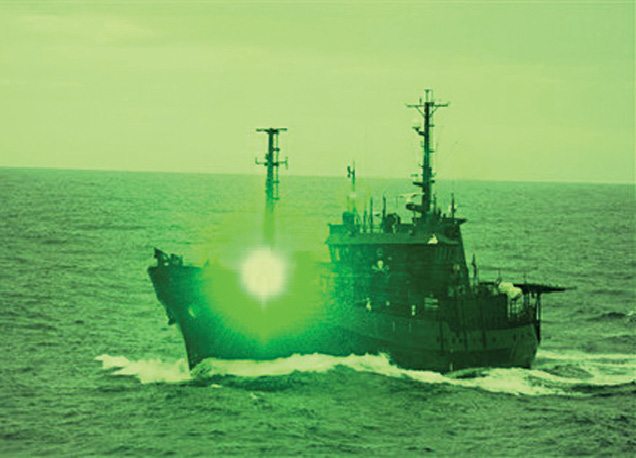Potential applications
Non-lethal laser weapons act as a force multiplier, enabling friendly forces to discourage, delay or prevent hostile action. A laser dazzler is a non-lethal weapon specifically designed for applications where subject vision impairment is to be achieved at a distance ranging from few tens of metres to several kilometres in bright ambient conditions. These are particularly effective in situations where use of lethal force is not preferred; examples being limiting escalation and temporarily disabling facilities and equipment.

Less-lethal laser weapons such as laser dazzlers can be used for counter-insurgency, anti-terrorism, counter-sniper, self-defence (Fig. 2) and crowd-control (Fig. 3) and infrastructure-protection applications.
Laser dazzlers are emerging internationally as the new non-lethal alternative to lethal force for law enforcement, homeland security (Fig. 4), border patrol, coastal protection, ship defence from asymmetric threats (Fig. 5), aircraft defence against shoulder-fired missiles (Fig. 6), infrastructure protection and host of other low-intensity conflict scenarios.
Such vehicles are usually equipped with remotely-controlled Laser weapons station for a wide range of applications. Technology of the short-range laser dazzler and crowd-control laser dazzler is more or less similar, except that the latter system employs a larger power source to be able to produce the desired power density in a larger beam spot. Some means of scanning the laser beam spot may also be necessary.

Laser dazzlers are also being considered as a potential candidate for warning the crew of commercial airliners or military aircraft who tend to violate intentionally or unintentionally the no-fly zone. Such systems in a networked configuration of multiple laser dazzler stations and radars could be effectively used for protection of critical infrastructure or assets.
In a system like this, the radar provides the initial clue about the rogue or suspect aircraft when it is still more than 100km away from the actual asset to be protected. It keeps a continuous vigil on the suspect aircraft till it comes within the tracking range of the electro-optic tracker, which is usually an integral part of the laser dazzler station.
The electro-optic tracker station takes the cue from the radar and tracks the target with much higher accuracy needed for the dazzling action. Exposure to a strong laser light source results in flash blindness and after-images. In flash blindness, exposure to a very bright light source deprives the pilot of vision for a period of time ranging from a few seconds to a few minutes.
Also, laser illumination fills the flight deck with a bright light, thus making it difficult to concentrate on flight instruments as well and adversely affecting pilot’s intended actions. Before the aircraft cockpit is flooded with dazzling laser light, much lower power levels are employed to send a kind of warning signal to the crew to know their intent. This helps in discriminating rogue aircraft from those that might have gone astray unintentionally.
Representative laser dazzler systems

A large number of companies are offering short- to medium-range laser dazzler systems for various application scenarios. One such short-range laser dazzler is Compact High Power (CHP) laser dazzler from LE systems, USA (Fig. 7). The dazzler emits 500mW flashing green dazzling laser beam. The CHP with its higher power creates a credible glare effect in a larger spot size for use on moving vehicles or individuals. This feature is particularly important for protection of entry control points and convoys, at distance, in bright ambient conditions. The CHP laser dazzler has been comprehensively evaluated to demonstrate no lasting eye damage from repeated direct exposures beyond the specified 20m stand-off distance.
GLARE MOUT is a non-lethal visual disruption laser with an effective range of 20m to 2km.The device is ideally suited for small arms integration as well as mobile crew-served applications. When a suspect approaches a restricted or controlled area, such a device can be used to give warning to that person before shots have to be fired. It is configured around 125mW green laser emitting at 532nm. It has an NOHD of 18m. Its shockingly bright-green beam sends an irrefutable, multi-lingual, cross-cultural, unambiguous message that you mean business. Reports confirm that GLARE MOUT has saved numerous lives of both soldiers and non-combatants in Iraq and Afghanistan.

GLARE GBD-IIIC, a long-range variant of GLARE MOUT, is a visual deterrent laser device for hail and warning applications. It is an effective dazzler ideally suited for ship-to-ship signaling or airborne over-watch. With twice the power and a more concentrated beam than GLARE MOUT, this device can effectively hail and warn as far away as 4km.
Like GLARE MOUT, GLARE GBD-IIIC produces an overtly bright-green diffused laser spot to impair the visual ability of a suspect. Fig. 8 shows the photograph of the device. It is configured around a 250mW green laser operating at 532nm. It has an operational range of 72m to 4000m with lower limit being the NOHD for the unaided eye. A fixed-beam divergence of 4mrad to 5mrad produces a spot size of about 30cm at the minimum operating range. With the optional eye-safety module, the device automatically shuts off when the targeted personnel are within the NOHD.
To know more about laser weapons, turn to page 3.










